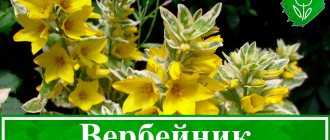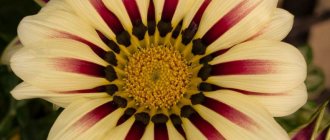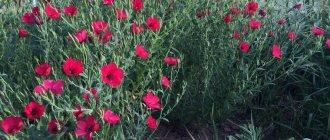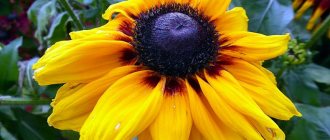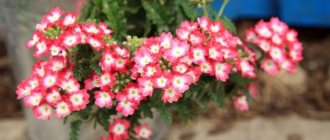Author: Elena N. https://floristics.info/ru/index.php?option=com_contact&view=contact&id=19 Category: Garden plants Published: February 26, 2019Last edits: January 13, 2021
- When to plant
- Rules of care
- How and when to collect seeds
- Gazania longiscapa
Gazania, or gazania, was brought to Europe from Mozambique. Today it is a popular garden crop everywhere. Gatsania crops produce almost one hundred percent germination, and flowering occurs quickly. One plant can have more than thirty inflorescences. Not only the golden baskets of gatsania are attractive, but also its bright green foliage, and some cultivars have downy stems and leaves, which gives them additional decorativeness.
From our article you will learn important details:
- about growing gatsaniya from seeds;
- about caring for the plant during the season;
- about how to collect seeds from a plant and how to preserve gatsaniya until spring.
Planting and caring for gatsaniya
- Planting: sowing seeds for seedlings in late March or early April with further planting of seedlings in open ground from mid-May to early June.
- Flowering: from June to November.
- Lighting: bright sunlight.
- Soil: light, nutritious, not waterlogged soil.
- Watering: moderate.
- Feeding: with a solution of complete mineral fertilizer once a month or one and a half, when growing on rocky soil - once every 2-4 weeks.
- Reproduction: seed.
- Pests: aphids, spider mites, snails and slugs.
- Diseases: gray rot.
Read more about growing gatsaniya below.
Gazania plant , or gazania , or African chamomile , belonging to the Asteraceae (Asteraceae) family, is represented by forty species that naturally grow in Mozambique and South Africa, as well as in the Australian coastal dunes. In the 17th century, the gazania flower appeared in Europe and received its current name in honor of the Italian priest Theodore von Gaza, famous for his translations of the works of Theophrastus and Aristotle. In Western Europe, this plant is called “midday gold” due to the fact that gatsania flowers, colored in warm shades, open at noon.
Answers to frequently asked questions
Beginner gardeners often have problems and difficulties. Let's look at the cases that happen most often.
- Which soil should I choose? Gatsania is unpretentious to the soil, but it is better to choose a special one for seedlings of flower crops.
- How can you speed up seed germination? The best way is to soak them overnight in a low concentration solution of potassium permanganate before planting.
- How to harden seedlings? About two weeks before planting in open ground, the containers are taken outside for 3-4 hours.
- What to do if growth has stopped. Most likely, the reason is improper care, violation of the watering schedule, and lack of nutrients. In this case, you need to try to establish the true reasons and get rid of them.
Gatsania, although an unusual flower for Russian gardens, is increasingly found in various landscape compositions
The main thing is to properly care for it, then it will become a real decoration of the garden or local area.
Botanical description
The annual or perennial gatsaniya is low-growing, reaching a height of no more than 30 cm. The basal leaves are collected in a rosette, the stem is either short or absent at all. The leaves are dark green or grayish-green, dense, varied in shape, with thick silvery fibers on the underside of the plate, which serve the plant as protection from cold and retain moisture in the dry season. The inflorescences are single baskets with a diameter of 5 to 9 cm, consisting of reed flowers of orange, red, yellow with dark spots at the base, forming a ring pattern around a yellow center consisting of tubular flowers. There can be about thirty-five such inflorescences on one plant. The fruit is a hairy achene with a tuft.
- How to sow aquilegia seeds for seedlings
Transplanting seedlings into the garden
As soon as the weather is consistently warm and the threat of frost has passed, you can transplant the flowers into the garden. In central Russia this is usually early-mid May - early June.
The seating scheme is 20 cm apart. Planting is done in deep holes for comfortable placement of roots.
Planted seedlings need to be watered and shaded for one or two days for adaptation. It is useful to provide them with shelter if there is a draft or strong wind. It is advisable to plant gatsaniya in the afternoon, when the sun is not so hot.
Care and proper watering
For abundant and long-lasting flowering, you need to take into account some nuances:
- the flower prefers sunny open places;
- moderate watering;
- the soil is light, nutritious, drainage;
- regular loosening and fertilizing every 2-3 weeks;
- The plant will bloom longer if you remove dried flowers in a timely manner.
Gatsania is an unpretentious resident of the garden; caring for it is simple: timely watering, fertilizing, loosening and removing weeds and dried flowers.
Growing gatsaniya from seeds
Sowing seedlings
Many lovers ask how to grow gatsania from seeds and when to sow gatsania for seedlings. The timing of sowing gatsaniya depends on the area in which you live. If your spring is late and cold, then planting gazania seedlings too early will require additional lighting for the growth of seedlings, because otherwise they will develop very slowly. On the other hand, if you sow the seeds late, for example in May, then the gatsaniya will bloom later.
Therefore, gatsania seeds are sown no earlier than mid-March, or even mid-April, in deep boxes so that the long tap root grows vertically, without bending. The soil in the boxes should be light, well-drained, pH 5.5-6.5.
You rarely need to sow, but it is better to simply arrange the seeds in a checkerboard pattern, keeping a distance of 2-3 cm between them. The seeds can be lightly sprinkled with soil on top, or you can simply press them tightly to the soil. Spray the seeds with a spray bottle, cover with film and place in a warm (18-20 ºC), bright place. It is necessary to ventilate and remove condensation daily. Shoots will appear in one to two weeks.
Growing seedlings
If the seedlings grow in a deep container, they do not need to be picked, but if the box is shallow, then after the fourth leaf appears on the seedlings, they are picked into peat pots and transferred for growing to a cooler room (12-16 ºC). An insulated but unheated loggia is suitable for this. At the same time, begin to accustom young plants to the temperature outside the window, opening the window briefly during the day, but so that the plants are not exposed to a draft.
In the photo: Growing gatsania in the garden
Wintering gatsaniya at home
The perennial nature of gazania allows it to be cultivated in winter at home. Before frost sets in, transplant the bush into a spacious pot and bring it indoors. For some time, bright baskets will decorate the windowsill, and closer to winter, the pots should be moved to a cool, well-lit place. The optimal temperature is not higher than 10⁰C. The irrigation regime is moderate; if necessary, the bush is illuminated with a phytolamp.
Important! Before planting in a flower bed next spring, shorten the stems by half.
Planting gatsaniya
When to plant
Planting seedlings in open ground is carried out from mid-May to early June, and in the future, caring for the gatsaniya flower will not be a punishment for you.
First you need to find a suitable site for the plant: an open sunny place with nutritious but light garden soil.
- Flower care in September
Sunlight is vital for gatsaniya; even direct sunlight does not frighten it, since it is extremely light-loving and even drought-resistant.
In the photo: How gatsaniya blooms in open ground
How to plant
Gatsania seedlings are transplanted into open ground along with the pots in which the seedlings grew. If you grew your seedlings in a box, use a long scoop to remove each seedling with its root ball and transfer it to the hole without damaging the root system. The distance between gatsania bushes should be at least 20 cm. Gatsania from seeds blooms soon after transplanting into open ground, three months after sowing the seeds.
How to grow lobelia from seeds: sowing for seedlings and in the ground
How to plant in peat tablets
Peat tablets are an ideal option for seedlings. Young shoots of these do not need to be transplanted into open ground, since they decompose in the soil, enriching it with nutrients.
How to use peat tablets correctly?
- soak them briefly in water: as soon as they increase in volume several times, you can take them out;
- place a gazania seed in the center of the tablet;
- sprinkle with soil on top - one handful (3-5 mm) is enough;
- spray the soil surface with water from a spray bottle;
- Place all the tablets in a common container and cover with cling film - the seeds will germinate faster there.
In addition, instead of tablets, you can use peat cups. they are also easy to use, but do not need to be pre-cooked or soaked
Gatsaniya care
Rules of care
The conditions for growing gazania, as already mentioned, are bright sunlight and well-drained soil. But, despite its love for warmth, gatsaniya can also tolerate sudden cold snaps down to -5...-7 ºC. Caring for gatsaniya in the garden consists of moderate watering, followed by loosening the soil and removing weeds and timely removal of faded inflorescences so that the plant quickly forms new buds.
Mulching the soil is also encouraged, as it allows you to retain moisture in the soil longer in the summer heat and reduces the amount of weeds on the site.
Growing gatsaniya flowers also involves fertilizing with fertilizers: if your gatsaniya grows on fertile soil, you need to feed it once a month and a half with a solution of complete mineral fertilizer at the rate of 20-25 g per square meter, but if you planted it on rocky, poor soil, then You will have to fertilize once every 2-4 weeks.
In the photo: Growing gatsania in a flowerbed
Flowering plant
Gatsania blooms from June to November, and the flowering of each basket lasts about three weeks. In the dark and in cloudy weather, the reed flowers of gatsania curl up, covering the yellow center of the tubular flowers.
- Tulips: late planting method
Sometimes gardeners complain that gatsaniya does not want to bloom. This may be due to insufficient lighting, excessive watering, or transplanting seedlings into open ground too late. Try not to violate the agrotechnical requirements of gatsaniya, and it will bloom on time and abundantly.
Pests and diseases
Anyone who has grown gatsaniya will tell you that it does not get sick. But if growing conditions are unfavorable for the plant, it weakens, and then it can be affected by gray rot. You will have to remove diseased specimens and treat the remaining plants with Fitosporin.
Among the insects that harm gatsania are snails, aphids and spider mites. Snails need to be collected by hand, and insects are destroyed with insecticides: aphids - Fitoverm, Akarin, Inta-vir, and spider mites - Actellik, Fufanon or Ditox.
In the photo: A combination of different varieties of gatsanias in a flowerbed
Diseases and pests of crops
Nature has endowed the African guest with strong immunity. The only disease that can plague bright chamomile is gray rot. It occurs when watering rules are violated or when the summer is cool and rainy. In case of minor fungal infection, the infected parts of the bush are removed and treated with a fungicide. If the disease takes over, destroy the diseased specimen. Such a radical method of treatment will protect neighbors in the flowerbed from infection.
Slugs, spider mites and aphids pose a danger to the overseas guest. Insects are destroyed with systemic insecticides, shellfish are collected manually or traps are installed. Experienced gardeners recommend beer bait for catching the pest. A bottle with a small amount of drink is dropped at an angle so that the neck is level with the ground. Periodically update the bait by destroying the caught mollusks.
Gatsaniya after flowering
How and when to collect seeds
In our climatic conditions, gatsania seeds usually do not have time to ripen, unless the summer turns out to be hot, long and dry. In addition, mainly hybrid plant varieties are grown in culture, and their seeds do not retain species and varietal characteristics. And the most important obstacle for those who want to collect gatsania seeds is that, like dandelion seeds, when ripe, they simply fly away. Therefore, when gatsaniya begins to bloom, wrap several large flowers with gauze so that the seeds do not scatter, and secure it to the peduncle.
In the photo: Growing gatsania in a pot
Wintering of Gatsania
If you grow gatsaniya as an annual, simply destroy the remains of the plant after flowering. But you can try to save it for next year. To do this, the most beautiful still flowering bushes are dug up, transplanted into pots or boxes and stored in a well-lit room at a temperature of 8-10 ºC, watering them from time to time so that the soil does not dry out completely. In the spring, they are planted again in open ground, after shortening the shoots by half.
Planting and caring for gaillardia - advice from experienced gardeners
Varieties of gatsaniya, which one is better to choose
To date, quite a large number of different varieties have been bred. They differ in the shape and size of the buds, as well as their shade. There are burgundy, purple, white, yellow, red and multi-colored gatsaniyas.
The following varieties are most often planted in garden plots:
- Single-flowered, characterized by small bushes up to 15 centimeters high, on which small yellow buds bloom.
Gatsaniya single-flowered
- Long-shooting, which also has small sizes and bright yellow buds, but the shade of the petals “shimmers”: from rich brown to yellow like a gradient.
- White, having the greatest resistance to sunlight.
Gatsania white
- Pinnate, characterized by a rather large bush height - up to 30 centimeters, which is a lot when compared with other varieties. In addition, bushes of this species may have buds of different colors with contrasting stripes on the petals.
Gazania pinnate
- Peacock, which has bushes 30-35 centimeters high, on which buds of rich colors grow with long and narrow leaves.
Gatsania peacock
An interesting feature of Gatsania is that it blooms only in the presence of sunlight. It closes at night or in cloudy weather.
Types and varieties
Gazania longiscapa
An annual plant 15-20 cm high, the basal leaves are entire, slightly split, pubescent below, bright green above. The basket, up to 7 cm in diameter, consists of tubular and reed flowers of bright yellow color, with the bases of the reeds being colored brown.
In the photo: Gazania longiscapa
Gazania harsh or shiny (Gazania rigens, Gazania splendens)
Stems up to 30 cm tall, baskets from 4.5 to 6 cm in diameter. The tubular flowers are blood-black, the ligulate flowers are bright yellow, red or orange with black, brown or white spots at the base. The leaves are usually entire, but sometimes pinnately divided.
In the photo: Gazania harsh or shiny (Gazania rigens, Gazania splendens)
Gazania pottsii
An enlarged copy of gatsaniya harsh: the basket has a diameter of up to 12 cm.
Gazania pavonia
It differs from others in the shape of its leaves - narrow, long (up to 20 cm). A basket up to 8 cm in diameter with yellow-orange reed flowers with a black base and a yellow center of tubular flowers.
In the photo: Gazania pavonia
Also grown in cultivation are feathery gazania (Gazania pinnata), snow-white gazania (Gazania nivea), single-flowered gazania (Gazania unifiora) and hybrid gazania (Gazania x hybrida), obtained by crossing various species, but mainly long-lined and harsh gazania. Hybrid Gatsania varieties developed in recent years are capable of blooming even on cloudy days.
Of the most popular varieties of hybrid gatsania, it is worth mentioning:
- Daybreak Red Stripe - light yellow inflorescences with red stripes, opening in the morning and closing only at dusk;
- variety mixture Talent - a hit in 2001 with beautiful leaves and inflorescences that close only at night;
- Ministar variety group - varieties with yellow, white and orange baskets.
Gatsania - description, photos, varieties
Gatsania (pictured) is one of the most prominent representatives of the Asteraceae family. The homeland of the plant is located in the Cape Flower Kingdom of South Africa, Mozambique. Some species are found on the coast of the Australian continent.
African daisies are low herbaceous plants with a short stem. According to the type of vegetation they are divided into annual and perennial species. The basal rosette is represented by dark green dense leaves. In most species, the underside of the plate is covered with dense pubescence. The edge helps gatsaniya to survive in harsh conditions. Small hairs reliably protect from heat, cold, and serve to collect moisture. The shape of the plates is varied - lanceolate, pinnate, linear. Sometimes small teeth run along the edge.
The inflorescences are represented by large single baskets. They sit on low peduncles. Reed flowers are painted in bright colors. Single or double corollas are white, yellow, red, brown, and orange. The diameter of the basket reaches 5-12 cm. The petals are often elongated-oval with a pointed tip. Among other representatives of the Asteraceae family, gatsanias are easily recognized by the dark pattern at the bottom of the petals. Small peacock eyes effectively outline the core of the flower.
This is interesting! African chamomile is a true plant forecaster. On the eve of bad weather and after sunset, the petals curl, protecting the pollen located in the tubular flowers of the core. For this property, Europeans nicknamed gazania midday gold, because you can admire the flowering only in good weather.
The decorative period of African chamomile begins in mid-summer. Each basket will delight the eye for more than a month; the bright inflorescences will be destroyed only by the approach of winter. In place of wilted heads, small achenes are formed that remain viable for no more than 2 years. The seed is covered with hairs, and there is a fluffy tuft on the top of the head. In nature, gatsanias reproduce by wind dispersing. Some varieties can be reproduced by cuttings.
Gazanias gained fame in the 18th century. European breeders put a lot of effort into giving the flower a bright palette of colors. Although the heat-loving beauty is a perennial, in most regions of Russia colorful varieties are grown as an annual plant. In addition to hybrid varieties, the following botanical species are most often found in culture:
- long-armed;
- harsh;
- single-flowered;
- peacock
The long-shooting species is an annual. The height of the bush does not exceed 20 cm. The culture has creeping shoots. Leaf blades with an entire edge, less often with small denticles. The upper side of the leaf is rich green, the bottom of the leaf is densely pubescent with white hairs. Chamomile-shaped inflorescences reach a diameter of 7 cm. The middle of the basket is yellow, the petals are golden with a brown eye at the base. Decorative period from August until the end of the season. Reproduction is mainly by seed.
Stiff gazania is a perennial 20-30 cm high. Short shoots are densely covered with dense, whole leaves of an elongated lanceolate shape. The upper side of the sessile leaves is dark green, with a dense edge located below. The diameter of the basket is 5-7 cm. The core is painted in purple or black tones, the petals are yellow, orange or red with a brown or black eye at the base. This species begins to bloom in mid-June; the decorative period ends with the onset of frost.
Know! The harsh variety stands out for its abundant flowering. Each plant produces up to 35 heads per season.
The growth of a single-flowered gazania does not exceed 15 cm. The plants have creeping shoots with long foliage of various shapes. The underside of the leaf is silvery due to the hairs; the leaves on top are bare and dark green. The flower, 4-5 cm in diameter, is painted in delicate yellow tones. During flowering, the crop forms dense flower carpets. The decorative period lasts from mid-summer until the onset of cold weather.
The peacock variety is a perennial subshrub. Bushes 30-35 cm high have a shortened stem and long narrow leaves (up to 20 cm). The underside of the leaves is silvery, pubescent, the upper side is green. Large flowers reach a diameter of 8-12 cm. The tubular center is yellow, the reeds are painted in bright orange tones with a black eye at the base. Flowering begins in mid-summer.
Based on the listed botanical varieties, an excellent hybrid gazania was obtained. Cultivars of hybrid origin have a multi-year development cycle. Their height is 20-30 cm. The foliage is lanceolate or linear, less often dissected. The surface of the plate is green, the bottom is silver with a thick edge. The average diameter of the inflorescence is 7-8 cm, but sometimes daisies reach 15 cm in diameter! The palette of bright tongues is varied. Hybrid varieties are characterized by high decorativeness, a long flowering period, and frost resistance.
Attention! Do not fall for the tricks of sellers, because new terry varieties are propagated exclusively by cuttings. When breeding from seeds, heterogeneous offspring are obtained.
The spectacular African chamomile can decorate any flower garden, alpine hill, rock garden, or ridge. In 2001, a unique variety mixture, Talent, was obtained, the petals of which remain open even in bad weather.
How to plant and grow seedlings
When the container is ready, you can start sowing. After the first shoots appear, a long root will begin to form.
Attention!
You need to make sure that it doesn’t break or bend in the container. Otherwise, nothing worked.
The container must be covered with a transparent lid. If you don’t have it, you can use cling film or cellophane.
The soil in which sowing will be carried out must have a light structure, but at the same time it must be nutritious. It is better to take soil from a flower bed. To improve its characteristics, it must be steamed in a water bath or heated in the oven for at least 20 minutes. After this, add vermiculite (replacing with coarse sand is acceptable) and wood ash, which prevents the proliferation of fungal infections.
It is not difficult to sow gatsaniya seeds, because... they are large. The procedure algorithm is as follows:
- prepare several grooves of small depth on the surface of the soil mixture - they are necessary for planning. The distance between them is 3 cm;
- spread the seed material, keeping a distance of 2 cm;
- sprinkle with sand-soil mixture, a layer of no more than 1 cm;
- spray with clean water or diluted growth stimulator.
In some cases, the soil mixture is covered with snow. If it is not on your face, then it is acceptable to take it from the freezer. When it melts, natural stratification will occur, combined with watering.
Use in landscape design
Gazania flower beds can not only complement the landscape design of a summer cottage, but also become its highlight, because they bloom from mid-summer until late autumn. These plants look great both as single bushes and when planted in huge multi-colored flower beds.
Planting gatsanias near large shrubs and tall plants should be avoided - the latter will take away moisture from it and create shade. Gazanias can also look great in the design of garden paths, alpine slides or rockeries.
In the next video you will learn the secrets of planting gazania to obtain a lush bush.
Growing and Reproduction
In the garden, Gazania will delight you with its flowering 2-3 months after planting the seeds. You can sow the seeds when the threat of frost has passed. Growing seedlings will speed up the flowering time.
Wintering
Gazania is a perennial crop, native to tropical regions and grown as an annual in our region. You can keep the plant at home, in a pot as an indoor flower, or in a heated greenhouse. An important condition for wintering is good lighting and a temperature of at least 10 degrees. This plant cannot survive the winter even in the southern regions of Russia.
Propagation by cuttings
Growing African chamomile from cuttings is not a popular method. To do this, you need to cut a cutting no more than 10 cm high, treat it with “Kornevin” with a “heel” for two hours and plant it in nutritious soil.
Growing gatsaniya from seeds
The most common way to grow Gazania is from seeds. It is quite difficult to collect seeds yourself because... After flowering, the inflorescence looks like a dandelion. Many species from the middle zone are hybrids, which means that the offspring from seeds will not resemble the maternal individual. Good strong plants from seeds germinate at a temperature of 20 degrees, the first shoots will appear in 1-2 weeks.
